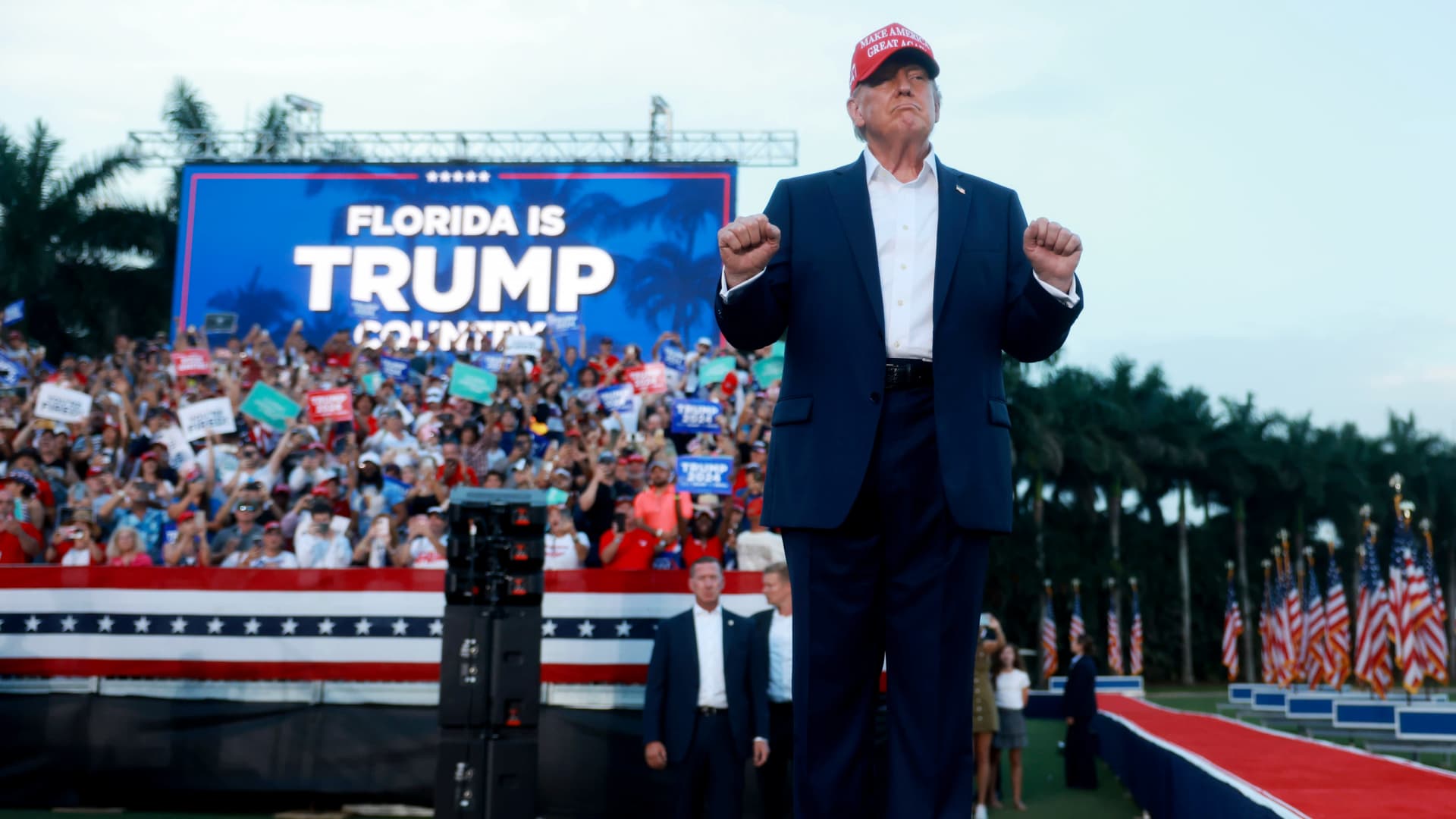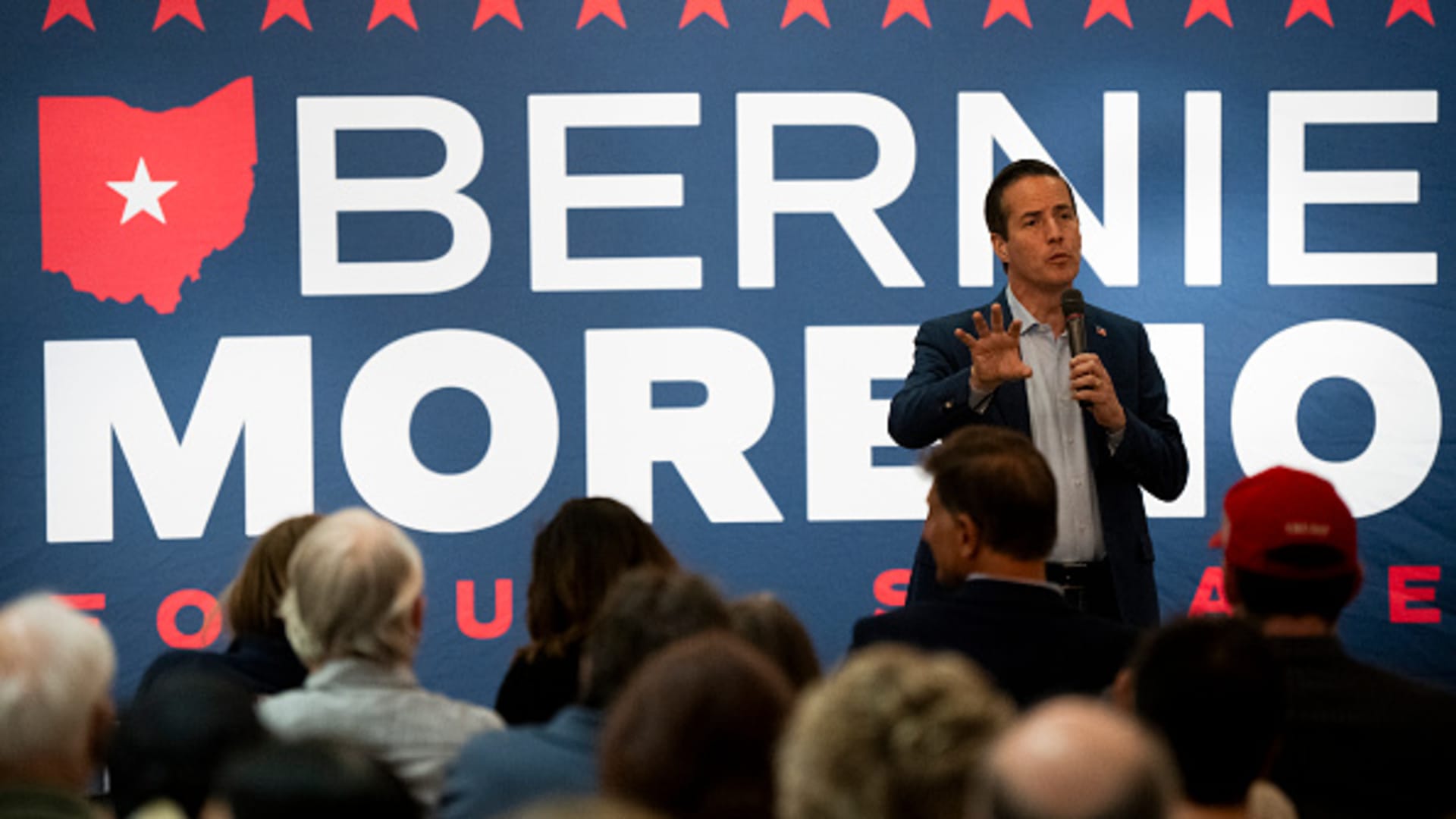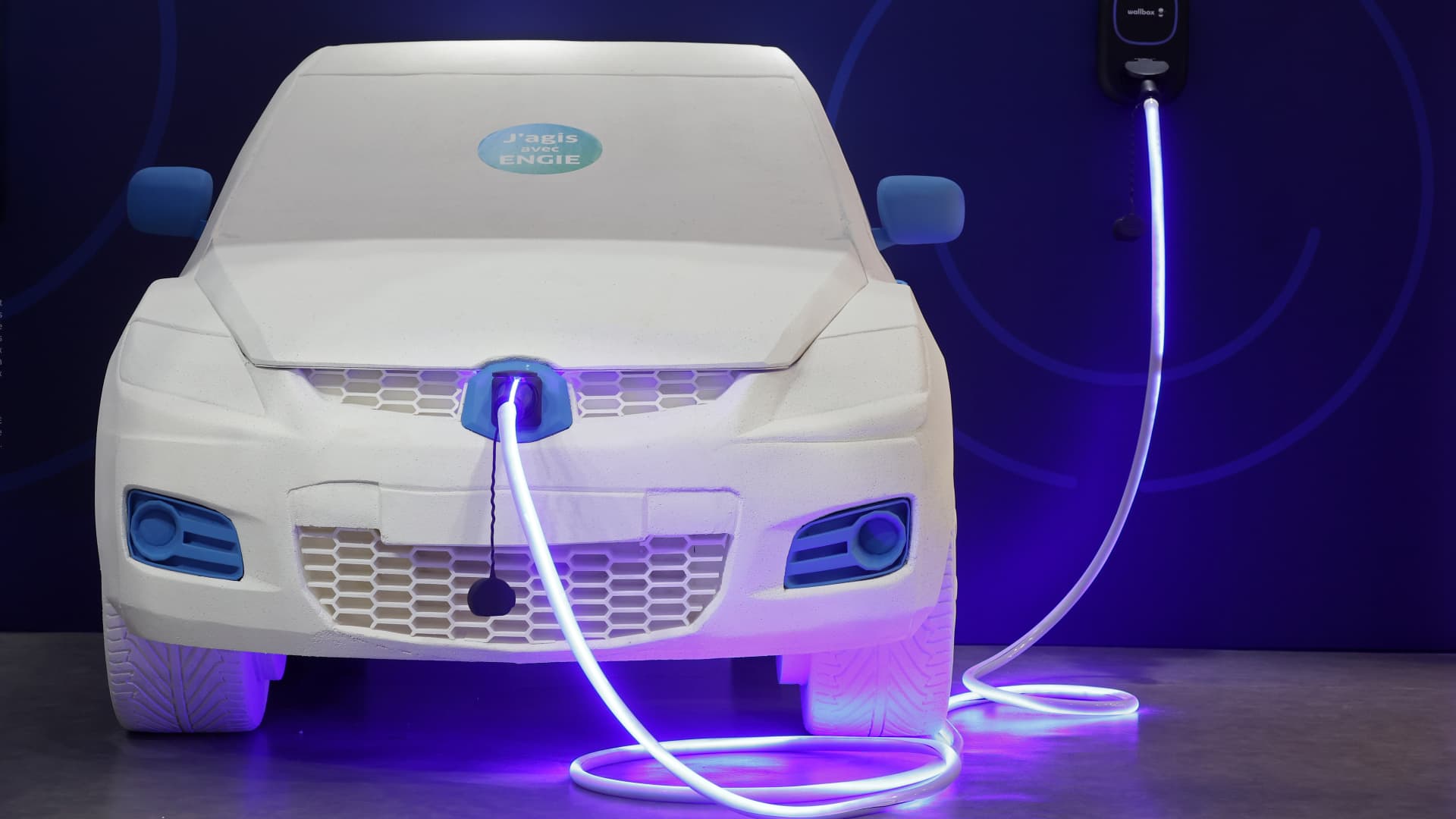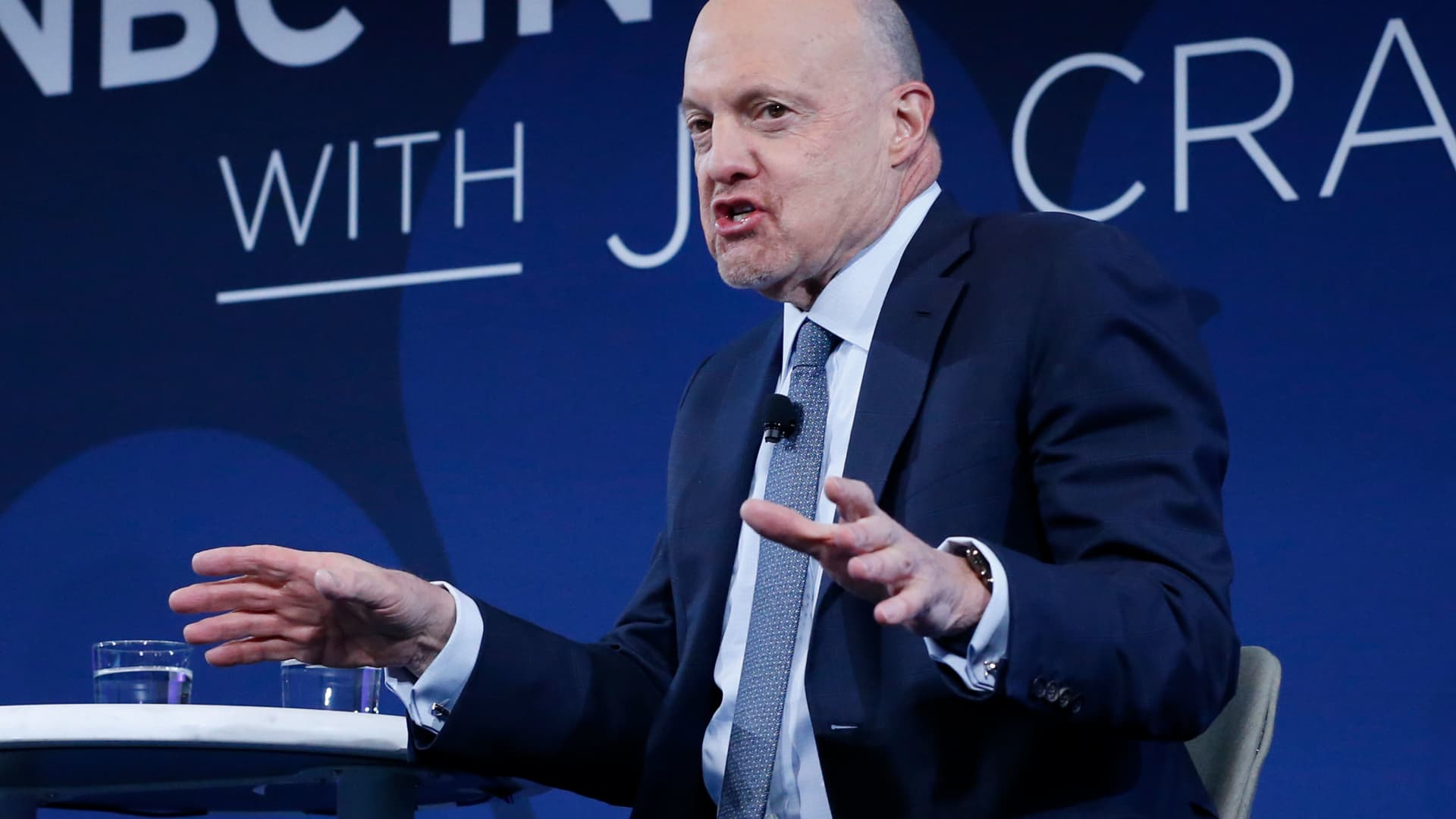Science & Environment
Trump claims presidential win. Here is what he promised the crypto industry ahead of the election

Former President Donald Trump arrives for his campaign rally at the Trump National Doral Golf Club in Doral, Florida, on July 9, 2024.
Joe Raedle | Getty Images News | Getty Images
As Donald Trump celebrated his prospective victory on Election Night at Mar-a-Lago, he was joined by a roster of high-profile supporters. Among them were Elon Musk, Robert F. Kennedy, Jr. and Cantor Fitzgerald CEO Howard Lutnick.
One thing those three people have in common: crypto.
It’s an industry that Trump talked little about until recently but has counted on for large amounts of cash for his campaign and related PACs. Getting that money required him to make big promises pertaining to the crypto industry.
Digital asset markets surged on Election Night, with bitcoin hitting a record of over $75,000, as his victory began looking likely. Crypto-linked stocks like Coinbase and MicroStrategy moved higher as well in after-hours trading Tuesday.
With a Republican-controlled Senate on the horizon, Trump has few roadblocks to putting in place a more pro-crypto platform. Here are some of the things he’s pledged to do:

Strategic national crypto stockpile
In Nashville in July, Trump headlined the biggest bitcoin conference of the year. In his keynote address, the former president said that if he returned to the White House, he would ensure the federal government never sells off its bitcoin holdings. However, he stopped short of proposing a formal federal reserve of digital currency.
“For too long our government has violated the cardinal rule that every bitcoiner knows by heart: Never sell your bitcoin,” Trump said during his keynote speech.
Trump pledged to maintain the current level of bitcoin holdings that the U.S. has amassed from seizing assets from financial criminals.
“If I am elected, it will be the policy of my administration, United States of America, to keep 100% of all the bitcoin the U.S. government currently holds or acquires into the future,” he said.
Currently, the U.S. Marshals Service regularly auctions off bitcoin as well as other cryptocurrencies held in the country’s coffers such as ether and litecoin. These sales can sometimes trigger drops in crypto prices, like earlier this year when Germany began to liquidate hundreds of millions of dollars worth of bitcoin it had seized.

‘On day one, I will fire Gary Gensler’
In public remarks for months, Trump has promised to unseat U.S. Securities and Exchange Commission Chairman Gary Gensler.
“On day one, I will fire Gary Gensler,” Trump said, referencing the Joe Biden-appointed SEC chairman who has taken an aggressive approach to crypto regulation.
The president does not have the power to fire the SEC chair. Even if Trump were to appoint a new chairman, Gensler would remain a commissioner on the independent agency.
Gensler has brought more than 100 actions against crypto firms during his tenure at the helm of the commission. In multiple interviews, the SEC chair has said he believes much of the industry already belongs under its jurisdiction, and its lawsuits are simply bringing the sector under compliance.
Crypto firms argue that the recent legal battles haven’t given the regulatory clarity the industry has been seeking, and they instead reflect a gross overreach by the commission.
Trump also vowed to create a “bitcoin and crypto presidential advisory council.”
“The rules will be written by people who love your industry, not hate your industry,” he said.
Trump has expressly spoken out about his qualms with Sen. Elizabeth Warren, D-Mass., who is widely viewed by the crypto community as an existential threat.

All bitcoin will be mined in America
In June in Palm Beach, Florida, about a dozen bitcoin mining executives and experts sat down with Trump for an hour and a half in a small tea room at the Mar-a-Lago Club. The closed-door session marked the first time the former president took a meeting with the technologists securing the $1.5 trillion bitcoin network by running large banks of high-powered machines.
The intimate gathering brought together a coalition of some of the biggest private and public American miners in the business, including representatives from Riot Platforms, Marathon Digital Holdings, Terawulf, CleanSpark and Core Scientific.
Less than four hours after Trump’s roundtable wrapped, the former president took to social media to extol the virtues of the bitcoin mining business.
“Biden’s hatred of Bitcoin only helps China, Russia, and the Radical Communist Left. We want all the remaining Bitcoin to be MADE IN THE USA!!! It will help us be ENERGY DOMINANT!!!” Trump posted on Truth Social shortly after his meeting.
Since then, Trump has on multiple occasions reiterated the sentiment.
“If crypto is going to define the future, I want it to be mined, minted and made in the USA,” Trump declared in Nashville.
“We will be creating so much electricity that you’ll be saying, ‘Please, please, President, we don’t want any more electricity. We can’t stand it!’” he added.
Fed rate cuts
In August, Trump said that, if elected, he would lower interest rates.
The Federal Reserve, which guides the country’s monetary policy, sets the benchmark rate. It also, by design, operates independently from the White House.
Fed Chair Jerome Powell in September decided to slash rates by a half point in its first easing campaign in four years.
Rate cuts and the easing of monetary policy historically dovetails with a surge in crypto prices since it makes it cheaper to borrow money.

Science & Environment
Bitcoiners celebrate as Bernie Moreno ousts Sherrod Brown, Ohio upset

Crypto fans are celebrating the results of the Ohio Senate race, where blockchain entrepreneur Bernie Moreno has defeated Senate Banking Chair Sherrod Brown, a three-term incumbent, in a contest that was key in the battle for control of the U.S. Senate.
Some $40 million of crypto money was directed at defeating Brown, with one PAC paying for five ads designed to boost awareness of Moreno, a businessman who worked as a luxury car dealer and had virtually no name recognition going into the contest.
The race was also a litmus test for whether the more than $245 million raised by the crypto industry this cycle would prove effective at the ballot box. The Ohio contest drew more ad spending than any Senate race in history, and was the biggest single target of crypto money this cycle.
Brown was unpopular with crypto fans, in part because he backed Sen. Elizabeth Warren, D-Mass., in holding hearings on whether digital tokens were tied to terrorism. He voted against pro-crypto legislation, called for more regulation of the sector, and regularly posted anti-crypto rhetoric on social media.
Ripple’s billionaire co-founder Chris Larsen told CNBC Tuesday night that Brown’s loss is “more fallout from the disastrous decision by President Joe Biden to outsource financial regulation to Sen. Warren.”
“Tonight I’m sad, but I’m never giving up,” Brown said in brief concession remarks Tuesday evening.
In December, Brown told journalists that he wasn’t concerned about the crypto industry’s rumblings against him.
“Bring ’em on,” Politico quoted Brown as saying to a crowd of reporters last year.
His antagonists are now taking a victory lap.
Tyler Winklevoss, one of the top individual crypto contributors this election cycle, called Brown a “crypto public enemy,” a “co-conspirator” to Sen. Warren, and a “Gary Gensler crony,” referring to the chair of the SEC. In a post on X, Winklevoss wrote, “The crypto army is striking!”
Coinbase CEO Brian Armstrong is equally excited.
“Tonight the crypto voter has spoken decisively — across party lines and in key races across the country,” Armstrong wrote in a post to X.
Armstrong called it the “most pro-crypto Congress ever” with more than 219 crypto-friendly candidates elected to the House and Senate.
The Stand With Crypto Alliance, launched by Coinbase last year, started a “Live election results” lander for crypto investors to keep track of the results. According to the tracker, 224 pro-crypto candidates have been elected to the House, against 106 anti-crypto House candidates that have won. In the Senate, 14 pro-crypto candidates have been elected, while nine anti-crypto candidates have been victorious.
NBC News hasn’t yet called all of these races.
Coinbase gave more than $75 million to Fairshake and its affiliated PACs, including a fresh pledge of $25 million to support the group in the 2026 midterms. Armstrong personally was among crypto’s top individual donors, giving over $1.3 million to a mix of candidates up and down the ballot.
Coinbase has been battling Gensler in court for more than a year over claims it sells unregistered securities.
The industry hopes that a pro-crypto Congress will pass rules that will apportion more of the regulatory responsibilities to the Commodities Future Trading Commission, which has traditionally been softer on its approach to policing the sector.
“Americans disproportionately care about crypto and want clear rules of the road for digital assets,” Armstrong wrote. “We look forward to working with the new Congress to deliver it. Thank you to everyone who stood with crypto today. We did it!”
The Fairshake affiliated PAC Defend American Jobs, which donated more than $40 million to Moreno, released a statement on Tuesday night, saying that Brown was a “top opponent of cryptocurrency.”
“Senator-Elect Moreno’s come-from-behind win shows that Ohio voters want a leader who prioritizes innovation, protects American economic interests, and will ensure our nation’s continued technological leadership,” the group said.
The political victories were reflected in the market.
Bitcoin surged to a new record above $75,000 earlier Tuesday night as the NBC News Decision Desk projected a good night for Republican nominee Donald Trump.
— CNBC’s Ece Yildirim contributed to this report.
Science & Environment
Solar stocks tumble overnight as Trump leads in election results

Copper Mountain Solar in El Dorado Valley, pictured on Thursday, Sept. 5, 2024, in Boulder City, Nevada. (Bizuayehu Tesfaye/Las Vegas Review-Journal/Tribune News Service via Getty Images)
Bizuayehu Tesfaye | Tribune News Service | Getty Images
Solar stocks sold off overnight as investors see Donald Trump leading in the U.S. presidential election.
Solar stocks are falling on fears that a possible Trump victory would spell trouble for the Inflation Reduction Act, which has fueled a clean energy boom in the U.S. through tax credits to expand solar energy.
The benchmark Invesco Solar ETF was down 7% in overnight trading on brokerage Robinhood. The solar panel manufacturer First Solar tumbled 8% overnight. Residential solar stocks Sunrun and Sunnova fell 6% and 2.6%, respectively. Inverter manufacturer Enphase tumbled 5% and Nextracker was down nearly 5%.
Trump’s campaign platform calls for the termination of the IRA, which he refers to as the “Socialist Green New Deal.” The IRA is one of President Joe Biden’s signature achievements. The law passed on party-line vote in 2022 without any Republican support.
Trump is leading in the electoral college and is projected to win the key swing state of North Carolina, according to NBC News. The future of the IRA, however, will depend not only on whether Trump wins the White House, but whether Republicans also secure control of Congress.
Kamala Harris’ campaign chair Jen O’Malley Dillon told staff in an email Tuesday that the clearest path to victory for the vice president lies in the so-called Blue Wall states of Pennsylvania, Michigan and Wisconsin.
Science & Environment
Crypto’s $245 million campaign finance operation funded non-crypto ads

Stand With Crypto’s bus tour through five battleground states kicked off last week in Phoenix and Las Vegas.
Logan Dobson/Stand With Crypto Alliance
LAS VEGAS — In Nevada’s 4th Congressional District, a crypto PAC spent nearly $2 million on ads this cycle to support the reelection of Steven Horsford, a Democratic congressman who’s voted in favor of some major pro-crypto bills.
But watching the ads, you’d learn nothing about that agenda.
“He’s leading on jobs, bringing good paying union jobs to Nevada and rebuilding our infrastructure,” one 30-second commercial says. “He capped insulin prices at $35 a month,” and “worked multiple jobs to support his hard working single mother and siblings in Congress.”
The ad wraps up with the disclosure, “Fairshake is responsible for the content of this ad.”
Fairshake was the largest crypto-aligned super PAC in the 2024 election cycle, spending piles of cash to support crypto allies and vote out antagonists across the country. The group brought in $170 million, accounting for a huge chunk of the amount raised by crypto-related PACs and other groups, which totaled more than $245 million, according to Federal Election Commission data.
Crypto has accounted for nearly half of all corporate money flowing into the election, according to a report from nonprofit watchdog Public Citizen. No other sector is close. That includes oil companies and banks, which have historically been big political contributors. Crypto even outpaced Elon Musk, the world’s richest person, who spent tens of millions of dollars to try and get Republican nominee Donald Trump back in the White House in his contest against Democratic Vice President Kamala Harris.
A big part of the crypto industry’s strategy when it came to distributing cash was to identify key races and then flood the zone.
Industry advocacy group Stand With Crypto Alliance, launched by Coinbase last year, developed a grading system for the presidential race and for House and Senate candidates across the country, helping it determine where to spend.

Horsford received an A grade based on his public comments and his voting history while in office. His campaign received money from Fairshake as well as individual donations from Coinbase CEO Brian Armstrong, Ripple co-founder Chris Larsen, venture capitalist and longtime crypto investor Reid Hoffman and billionaire twins Cameron and Tyler Winklevoss.
Nevada is home to two of the thirteen “critical elections” singled out by Stand with Crypto, a designation the group defines as races that are “critical to the future of crypto in America.” In addition to Horsford’s election, the other Nevada race is the Senate contest between Democratic incumbent Jackie Rosen and Republican challenger Sam Brown. Both candidates received an A grade.
According to data shared by Stand with Crypto, 385,000 Nevadans are crypto owners, and more than 16,000 people in the state have signed up to be advocates for the group, which made a stop in Las Vegas in September as part of a multi-state tour.
The other races deemed critical were for Senate in Montana, Ohio, Pennsylvania, Arizona, Massachusetts, Michigan, Wisconsin, and Maryland, and for specific House contests in Colorado, Iowa and Oregon.
To reach potential voters, Fairshake isn’t talking a lot about crypto. Nor are its affiliate PACs, which have names like Defend American Jobs and Protect Progress. They’ve collectively spent more than $135 million this cycle, mostly on ads.
“Not mentioning crypto assets explicitly is probably a savvy move to avoid alienating voters who prefer traditional currencies and might be put off by connections to crypto,” said David Nickerson, an associate professor of political science at Temple University who worked in the analytics department for President Barack Obama’s re-election campaign in 2012.
The biggest single target of crypto money this cycle was Ohio Sen. Sherrod Brown, the Democratic chair of the Senate Banking Committee. Brown backed Sen. Elizabeth Warren, D-Mass., in holding hearings on whether digital tokens were tied to terrorism.
In December, Brown told journalists that he wasn’t concerned about the crypto industry’s rumblings against him.
“Bring em’ on,” Politico quoted Brown as saying to a crowd of reporters.
Some $40 million of crypto money has been directed at defeating Brown, and one PAC has paid for five ads designed to boost awareness of Republican rival Bernie Moreno, a blockchain entrepreneur. The race is crucial in determining which party will control the Senate.
Protect Progress, a PAC affiliated with Fairshake, has given more than $10 million apiece to Senate candidates in Arizona and Michigan. In Arizona, the group favors Democrat Ruben Gallego, who is vying for the seat being vacated by Kyrsten Sinema. In Michigan, the preferred choice is Elissa Slotkin, who is currently a Democratic House member.
Democratic Rep. Katie Porter lost in the primary for the California Senate after Fairshake spent over $10 million in ads against her. Defend American Jobs spent more than $3 million to support Republican Jim Justice in West Virginia, who has been declared the winner in West Virginia, replacing exiting Democratic Sen. Joe Manchin.
WATCH: Jay Clayton on regulation

Science & Environment
Jim Cramer is encouraged by updates on 3 stocks that indicate further upside ahead
Science & Environment
Coinbase’s big election bet is about to be tested


WASHINGTON — In the first few years after founding Coinbase, CEO Brian Armstrong shied away from Washington, D.C. But as his ambitions for his crypto exchange scaled, so too did his need to curry favor on Capitol Hill.
“About five or six years ago, we realized that crypto was getting big enough that we needed to go really engage actively in a policy effort, so I started coming out to D.C.,” Armstrong, who started Coinbase in 2012, told CNBC in September, following a day of meetings with political leaders.
Now, it’s practically Armstrong’s full-time job, and Coinbase’s money is all over the nation’s capital. The company was one of the top corporate donors this election cycle, giving more than $75 million to a group called Fairshake and its affiliate PACs, including a fresh pledge of $25 million to support the pro-crypto super PAC in the 2026 midterms. Armstrong personally contributed over $1.3 million to a mix of candidates up and down the ballot.
The tech industry’s biggest names have dotted Washington for years to try and push their agendas as their market caps have expanded, but for Coinbase, the matter is potentially existential.
SEC Chair Gary Gensler sued the firm last year over claims that it sells unregistered securities. A judge has since ruled that the case should be heard by a jury. Coinbase has fought back vociferously, and has also said that it wants to work with regulators to come up with a proper set of laws governing the nascent industry.
Meanwhile, Coinbase faces a growing list of competitors.
In the company’s latest quarterly earnings report last week, Coinbase missed on the top and bottom lines due to lower transaction revenues and a drop in subscription and services revenues. The shares plummeted 15%.
Data from CCData shows the exchange is losing spot market share to industry rivals like Crypto.com. And investors have many new options for accessing bitcoin and ethereum since the SEC greenlit spot funds this year. BlackRock’s ETF chief Samara Cohen told CNBC that 75% of its bitcoin buyers are crypto investors who are new to Wall Street.
Washington can’t save Coinbase from the competition, but the company is betting that, with favorable lawmakers in place, it can be the leader in a thriving industry rather than under the constant threat of lawsuits and Wells notices.
Armstrong said his D.C. visits normally took place once or twice a year. Then it got to be at least a quarterly occasion. And the pace has only increased.
“In the beginning, a lot of people didn’t know what crypto was,” Armstrong said of his earlier trips. Now, “the discussion has advanced, really, to, how do we pass clear rules, create legislation in the United States?”

An SEC sans Chair Gensler
Paul Grewal, Coinbase’s chief legal officer, attended a fundraiser in San Francisco in June that raised $12 million for former President Donald Trump. It was hosted by venture capitalist David Sacks, a former Trump critic who became an outspoken supporter when he became the Republican nominee.
Grewal later joined a fundraiser in Nashville in July for the former president.
Trump has never shown much of an aptitude for the nuances of crypto, but he’s welcomed the industry’s financial support. He was applauded in the summer, when he vowed to fire Gensler as head of the SEC if he wins.
Grewal told CNBC that he’s had “many conversations” behind closed doors with both the Trump camp as well as Democratic Vice President Kamala Harris’ campaign. Heading into Election Day on Tuesday, the candidates were in a virtual dead-heat.
“What I think we’re hearing from both campaigns is they get it,” Grewal said. “They understand that in swing state after swing state, there are enough voters who care about crypto that the candidate and their campaigns need to give voice to the concerns of those voters in supporting sensible rules for crypto, sensible legislation coming out of Congress, and that’s very encouraging.”
Grewal said that Trump “came earlier to this pro-crypto view,” but said that Harris recognizes the need for “an agenda focused on promoting sensible rules for crypto as much as any other technology.”
But Coinbase’s political interests as an organization have been focused exclusively on Congressional races, as the company looks to help assemble a group of lawmakers with favorable views of the industry.
The Stand With Crypto Alliance, launched by Coinbase last year, has developed a grading system for House and Senate candidates across the country.
In the Ohio Senate race, for example, the organization gives Democratic incumbent Sen. Sherrod Brown, who chairs the banking committee, an “F” grade, versus an “A” grade for his Republican rival Bernie Moreno, a blockchain entrepreneur. Some $40 million of crypto money has been directed at defeating Brown, and one PAC has paid for five ads designed to boost awareness of Moreno. The race is very close and is crucial in determining which party will control the Senate.
Stand with Crypto, which has enrolled 1.4 million advocates across the country, is also working to mobilize digital asset owners living in swing states. This effort involved a cross-country bus tour through battlegrounds focused on getting these residents registered to vote.

“It’s really extraordinary, given how razor-thin the margin of victory was in the 2020 election, to see crypto not only be an issue, but potentially a determinative issue in terms of the presidential cycle,” Faryar Shirzad, Coinbase’s chief policy officer, said in an interview.
Shirzad said that last year, he and his team concluded that the only way to get politics out of crypto was “to build our own political operation.” He said the goal is to “neutralization the politicization of the crypto issue and talk about it on the merits.”
Coinbase is far from alone. Nearly half of all corporate money raised this election comes from crypto firms.
Fairshake, one of the top spending PACs this cycle, told CNBC it’s raised around $170 million this election and disbursed approximately $135 million.
Ripple Labs is another one of Fairshake’s top political donors.
The company, which has spent more than $100 million battling Gensler, has given around $50 million to Fairshake. Several executives have also contributed to a mix of Democratic and Republican candidates in races across the country.
Ripple’s head of U.S. public policy, Lauren Belive, told CNBC at a fintech conference in Las Vegas that the company was motivated by the SEC’s overreach.
“We really wanted to put people into office that could learn about this technology and understand this technology, because we need Congress to act and to create federal statutes and not have this enforcement regime,” said Belive. She added the regulator has issued over 100 enforcement actions against crypto-aligned companies.

The crypto voter
Stand with Crypto’s bus tour culminated in a rally held at The Black Cat in Washington on a Wednesday night in September.
The popular music venue has no windows and gives off an “Alice in Wonderland” vibe, with its mix of purple-painted walls and exposed brick, along with its black-and-white checkered floor.
As music blared and drinks flowed, free “Stand with Crypto” merch was being handed out to attendees. Surplus goodie bags were generously doled out to those looking to take extras back home.
Armstrong slipped out of his black SUV to speak to CNBC just outside the venue. He donned a suit and tie, a stark contrast to his fellow attendees. Armstrong said he was confident about the upcoming election.
“The crypto voter has become a major part of this election now,” Armstrong said. “I think the crypto voter is really real, and we’ll see what happens in November.”
In addition to Armstrong, Consensys CEO Joe Lubin, and Rep. Wiley Nickel (D-N.C.) spoke at the rally. Most remarks were inaudible over the roaring buzz of the crowd.
A hush fell over the audience when the headline act, The Chainsmokers, took the stage. The band started with its 2017 classic “Paris,” and the crowd chimed in at the chorus: “If we go down, then we go down together.”
WATCH: Bitcoin slumps to $67,000 level on eve of U.S. election: CNBC Crypto World

Science & Environment
Silicon anodes are ahead of solid-state batteries in race to power EVs

A Wallbox EV charger for electric car is displayed during the “Mondial de l’Auto” at Parc des Expositions on October 15, 2024 in Paris, France.
Chesnot | Getty Images News | Getty Images
Silicon anodes appear to be leading the way in the race to commercialize next-generation battery technologies for electric vehicles.
The buzz around silicon-based anodes, which promise improved power and faster charging capabilities for EVs, has been growing in recent months — just as the hype around solid-state batteries seems to have fizzled.
It comes as increasing EV sales continue to drive up global battery demand, prompting auto giants to team up with major cell manufacturers on the road to full electrification.
While some OEMs (original equipment manufacturers) have inked deals with solid-state battery developers, carmakers such as Mercedes, Porsche and GM have all bet big on silicon anodes to deliver transformative change in the science behind EVs.
A recent report from consultancy IDTechEx described the promise of advanced silicon anode materials as “immense” for improving critical areas of battery performance, noting that this potential hadn’t gone unnoticed by carmakers and key players in the battery industry.
It warned, however, that challenges such as cycle life, shelf life and — perhaps most importantly — cost, need to be addressed for widespread adoption.
Venkat Srinivasan, director of the Collaborative Center for Energy Storage Science at the U.S. government’s Argonne National Laboratory in Chicago, said silicon anodes appear to have the edge over solid-state batteries.
“If there’s a horse race, silicon does seem to be ahead at least at this moment, but we haven’t commercialized either one of them,” Srinivasan told CNBC via videoconference.
Srinivasan said five years ago silicon-anode batteries had a calendar life of roughly one year, but recent data appears to show a dramatic improvement in the durability of these materials, with some tests now projecting a three to four-year calendar life.
Unlike the cycle life of a battery, which counts the number of times it can be charged and discharged, the calendar life measures degradation over time. Typically, the calendar life of a battery refers to the period in which it can function at over 80% of its initial capacity, regardless of its usage.
Srinivasan said solid-state batteries, long billed as the “holy grail” of sustainable driving, still have a long way to go before they can match the recent progress made by silicon anodes.
“That transition still has to be made in solid-state with their metal batteries and that’s why I think you’re hearing from people that, hey, it looks like that promise hasn’t panned out,” Srinivasan said.
“That doesn’t mean we won’t get there. It may happen in a few years. It just means that it feels like today silicon is in a different part of the technology readiness level.”
Silicon anodes vs. solid-state batteries
Analysts say silicon anodes theoretically offer 10 times the energy density as graphite, which are commonly used in battery anodes today. Yet, these same materials typically suffer from rapid degradation when lots of silicon is used.
“Silicon anodes and solid-state batteries are two emerging technology trends in the EV battery market aimed at pushing the boundaries of high-performance battery cells,” Rory McNulty, senior research analyst at Benchmark Mineral Intelligence, told CNBC via email.
A researcher checks the electromagnet de-ironing machine at the Daejoo Electronic Materials Co. R&D center in Siheung, South Korea, on Thursday, June 22, 2023.
Bloomberg | Bloomberg | Getty Images
It has typically been the case that better battery performance comes at the cost of longevity or safety, McNulty said. Silicon anodes, for example, are known to swell significantly during charging, which reduces the battery’s longevity.
By comparison, McNulty said solid-state batteries were claimed to greatly improve the stability of the electrolyte to high performance electrode materials, combating the challenges of using high energy density materials such as silicon and lithium.
As the name suggests, solid-state batteries contain a solid electrolyte, made from materials such as ceramics. That makes them different from conventional lithium-ion batteries, which contain liquid electrolyte.
Especially in the West, advances in the area of silicon anodes [are] seen as strategic opportunity to catch up with China.
Georgi Georgiev
Battery raw materials analyst at Fastmarkets
Japan’s Toyota and Nissan have both said they are aiming to bring solid-state batteries into mass production over the coming years, while China’s SAIC Motor Corp reportedly said in early September that its MG brand would equip cars with solid-state batteries within the next 12 months.
Nonetheless, analysts remain skeptical about when solid-state batteries will actually make it to market.
A strategic opportunity?
“Silicon based anodes promise to be the next-generation technology in the anode field, providing a solution for faster charging,” Georgi Georgiev, battery raw materials analyst at consultancy Fastmarkets, told CNBC via email.
Georgiev said several industry players have been looking into the potential of silicon anodes, from well-established anode suppliers in China and South Korea to new players like Taiwan’s ProLogium and U.S. manufacturers Group14 and Sila Nanotechnologies.
“Especially in the West, advances in the area of silicon anodes [are] seen as strategic opportunity to catch up with China, which dominates the graphite-based anode supply chains with Chinese anode producers holding 98% of the global anode market for batteries,” Georgiev said.
“However, there are significant technical challenges going to 100% silicon anode such as silicon expansion affecting the longevity of the batteries and currently there are several routes to produce silicon anodes,” he added.
A FEV x ProLogium Technology Co. 100% silicon composite anode next-generation battery at the Paris Motor Show in Paris, France, on Tuesday, Oct. 15, 2024.
Bloomberg | Bloomberg | Getty Images
Taiwanese battery maker ProLogium debuted the world’s first fully silicon anode battery at the Paris Motor Show last month, saying it’s new fast-charging battery system not only surpassed traditional lithium-ion batteries in performance and charging efficiency but also “critical industry challenges.”
ProLogium, citing test data, said it’s 100% silicon anode battery could charge from 5% to 60% in just 5 minutes, and reach 80% in 8.5 minutes. It described the advancement as an “unmatched achievement in the competitive EV market,” which will help to reduce charging times and extend the range of EVs.
Fastmarkets’ Georgiev said a big question mark over the commercialization of silicon anodes is the cost of production and whether any of the major silicon-anode producers “could produce material at scale with a consistent quality and at a competitive price — [a] major requirements of OEMs.”
“At this stage silicon anodes are used more as an additive to graphite-based anodes and in the years to come we expect to see increase of silicon share in anode, but in combination with graphite, while 100% silicon anodes will take longer time to enter the mass market,” he added.
-

 Science & Environment2 months ago
Science & Environment2 months agoHow to unsnarl a tangle of threads, according to physics
-

 Technology1 month ago
Technology1 month agoIs sharing your smartphone PIN part of a healthy relationship?
-

 Science & Environment2 months ago
Science & Environment2 months agoHyperelastic gel is one of the stretchiest materials known to science
-

 Science & Environment2 months ago
Science & Environment2 months ago‘Running of the bulls’ festival crowds move like charged particles
-

 Technology2 months ago
Technology2 months agoWould-be reality TV contestants ‘not looking real’
-

 Science & Environment1 month ago
Science & Environment1 month agoX-rays reveal half-billion-year-old insect ancestor
-

 Money1 month ago
Money1 month agoWetherspoons issues update on closures – see the full list of five still at risk and 26 gone for good
-

 Science & Environment2 months ago
Science & Environment2 months agoMaxwell’s demon charges quantum batteries inside of a quantum computer
-

 Science & Environment2 months ago
Science & Environment2 months agoSunlight-trapping device can generate temperatures over 1000°C
-

 Sport1 month ago
Sport1 month agoAaron Ramsdale: Southampton goalkeeper left Arsenal for more game time
-

 Science & Environment2 months ago
Science & Environment2 months agoPhysicists have worked out how to melt any material
-

 Technology1 month ago
Technology1 month agoGmail gets redesigned summary cards with more data & features
-

 Football1 month ago
Football1 month agoRangers & Celtic ready for first SWPL derby showdown
-

 MMA1 month ago
MMA1 month ago‘Dirt decision’: Conor McGregor, pros react to Jose Aldo’s razor-thin loss at UFC 307
-

 News1 month ago
News1 month agoWoman who died of cancer ‘was misdiagnosed on phone call with GP’
-

 Technology1 month ago
Technology1 month agoUkraine is using AI to manage the removal of Russian landmines
-

 Science & Environment2 months ago
Science & Environment2 months agoLaser helps turn an electron into a coil of mass and charge
-

 Sport1 month ago
Sport1 month agoBoxing: World champion Nick Ball set for Liverpool homecoming against Ronny Rios
-

 Technology1 month ago
Technology1 month agoEpic Games CEO Tim Sweeney renews blast at ‘gatekeeper’ platform owners
-
Business1 month ago
how UniCredit built its Commerzbank stake
-

 Science & Environment2 months ago
Science & Environment2 months agoA new kind of experiment at the Large Hadron Collider could unravel quantum reality
-

 Science & Environment2 months ago
Science & Environment2 months agoLiquid crystals could improve quantum communication devices
-

 Technology1 month ago
Technology1 month agoRussia is building ground-based kamikaze robots out of old hoverboards
-

 News1 month ago
News1 month ago‘Blacks for Trump’ and Pennsylvania progressives play for undecided voters
-

 Technology1 month ago
Technology1 month agoSamsung Passkeys will work with Samsung’s smart home devices
-

 MMA1 month ago
MMA1 month agoDana White’s Contender Series 74 recap, analysis, winner grades
-

 Science & Environment2 months ago
Science & Environment2 months agoQuantum ‘supersolid’ matter stirred using magnets
-

 Science & Environment2 months ago
Science & Environment2 months agoWhy this is a golden age for life to thrive across the universe
-

 Technology1 month ago
Technology1 month agoMicrosoft just dropped Drasi, and it could change how we handle big data
-

 MMA1 month ago
MMA1 month ago‘Uncrowned queen’ Kayla Harrison tastes blood, wants UFC title run
-

 News1 month ago
News1 month agoNavigating the News Void: Opportunities for Revitalization
-

 Entertainment1 month ago
Entertainment1 month agoBruce Springsteen endorses Harris, calls Trump “most dangerous candidate for president in my lifetime”
-

 MMA1 month ago
MMA1 month agoPereira vs. Rountree prediction: Champ chases legend status
-

 News1 month ago
News1 month agoMassive blasts in Beirut after renewed Israeli air strikes
-

 Technology1 month ago
Technology1 month agoCheck, Remote, and Gusto discuss the future of work at Disrupt 2024
-

 Sport1 month ago
Sport1 month ago2024 ICC Women’s T20 World Cup: Pakistan beat Sri Lanka
-

 News1 month ago
News1 month agoRwanda restricts funeral sizes following outbreak
-

 TV1 month ago
TV1 month agoসারাদেশে দিনব্যাপী বৃষ্টির পূর্বাভাস; সমুদ্রবন্দরে ৩ নম্বর সংকেত | Weather Today | Jamuna TV
-

 Technology1 month ago
Technology1 month agoWhy Machines Learn: A clever primer makes sense of what makes AI possible
-

 Technology1 month ago
Technology1 month agoMicrophone made of atom-thick graphene could be used in smartphones
-

 Business1 month ago
Business1 month agoWater companies ‘failing to address customers’ concerns’
-

 News1 month ago
News1 month agoCornell is about to deport a student over Palestine activism
-

 Business1 month ago
Business1 month agoWhen to tip and when not to tip
-
Business1 month ago
Top shale boss says US ‘unusually vulnerable’ to Middle East oil shock
-

 News1 month ago
News1 month agoHull KR 10-8 Warrington Wolves – Robins reach first Super League Grand Final
-

 Sport1 month ago
Sport1 month agoWXV1: Canada 21-8 Ireland – Hosts make it two wins from two
-

 Science & Environment2 months ago
Science & Environment2 months agoQuantum forces used to automatically assemble tiny device
-

 News2 months ago
News2 months ago▶️ Hamas in the West Bank: Rising Support and Deadly Attacks You Might Not Know About
-

 MMA1 month ago
MMA1 month agoKayla Harrison gets involved in nasty war of words with Julianna Pena and Ketlen Vieira
-

 Technology1 month ago
Technology1 month agoSingleStore’s BryteFlow acquisition targets data integration
-

 Football1 month ago
Football1 month ago'Rangers outclassed and outplayed as Hearts stop rot'
-

 Science & Environment2 months ago
Science & Environment2 months agoITER: Is the world’s biggest fusion experiment dead after new delay to 2035?
-

 Science & Environment2 months ago
Science & Environment2 months agoA slight curve helps rocks make the biggest splash
-

 Technology2 months ago
Technology2 months agoMeta has a major opportunity to win the AI hardware race
-

 Science & Environment2 months ago
Science & Environment2 months agoNuclear fusion experiment overcomes two key operating hurdles
-

 Sport1 month ago
Sport1 month agoChina Open: Carlos Alcaraz recovers to beat Jannik Sinner in dramatic final
-

 Football1 month ago
Football1 month agoWhy does Prince William support Aston Villa?
-

 Technology1 month ago
Technology1 month agoLG C4 OLED smart TVs hit record-low prices ahead of Prime Day
-

 News1 month ago
News1 month ago▶ Hamas Spent $1B on Tunnels Instead of Investing in a Future for Gaza’s People
-

 Technology1 month ago
Technology1 month agoMusk faces SEC questions over X takeover
-

 MMA1 month ago
MMA1 month agoPennington vs. Peña pick: Can ex-champ recapture title?
-

 Sport1 month ago
Sport1 month agoPremiership Women’s Rugby: Exeter Chiefs boss unhappy with WXV clash
-

 Sport1 month ago
Sport1 month agoShanghai Masters: Jannik Sinner and Carlos Alcaraz win openers
-

 Sport1 month ago
Sport1 month agoCoco Gauff stages superb comeback to reach China Open final
-

 Womens Workouts1 month ago
Womens Workouts1 month ago3 Day Full Body Women’s Dumbbell Only Workout
-

 Technology1 month ago
Technology1 month agoUniversity examiners fail to spot ChatGPT answers in real-world test
-
Business1 month ago
Bank of England warns of ‘future stress’ from hedge fund bets against US Treasuries
-

 Sport1 month ago
Sport1 month agoSturm Graz: How Austrians ended Red Bull’s title dominance
-

 MMA1 month ago
MMA1 month ago‘I was fighting on automatic pilot’ at UFC 306
-

 News1 month ago
News1 month agoGerman Car Company Declares Bankruptcy – 200 Employees Lose Their Jobs
-

 Sport1 month ago
Sport1 month agoWales fall to second loss of WXV against Italy
-
Business1 month ago
DoJ accuses Donald Trump of ‘private criminal effort’ to overturn 2020 election
-
Business1 month ago
Sterling slides after Bailey says BoE could be ‘a bit more aggressive’ on rates
-

 TV1 month ago
TV1 month agoTV Patrol Express September 26, 2024
-

 Money4 weeks ago
Money4 weeks agoTiny clue on edge of £1 coin that makes it worth 2500 times its face value – do you have one lurking in your change?
-

 Science & Environment2 months ago
Science & Environment2 months agoTime travel sci-fi novel is a rip-roaringly good thought experiment
-

 Science & Environment2 months ago
Science & Environment2 months agoNerve fibres in the brain could generate quantum entanglement
-
Travel1 month ago
World of Hyatt welcomes iconic lifestyle brand in latest partnership
-

 Technology1 month ago
Technology1 month agoQuoroom acquires Investory to scale up its capital-raising platform for startups
-

 MMA1 month ago
MMA1 month agoKetlen Vieira vs. Kayla Harrison pick, start time, odds: UFC 307
-

 Technology1 month ago
Technology1 month agoThe best shows on Max (formerly HBO Max) right now
-

 Technology1 month ago
Technology1 month agoIf you’ve ever considered smart glasses, this Amazon deal is for you
-

 MMA1 month ago
MMA1 month agoHow to watch Salt Lake City title fights, lineup, odds, more
-

 Technology1 month ago
Technology1 month agoJ.B. Hunt and UP.Labs launch venture lab to build logistics startups
-

 Technology1 month ago
Technology1 month agoAmazon’s Ring just doubled the price of its alarm monitoring service for grandfathered customers
-
Business1 month ago
Italy seeks to raise more windfall taxes from companies
-
Business1 month ago
‘Let’s be more normal’ — and rival Tory strategies
-
Business1 month ago
The search for Japan’s ‘lost’ art
-

 Sport1 month ago
Sport1 month agoURC: Munster 23-0 Ospreys – hosts enjoy second win of season
-

 Sport1 month ago
Sport1 month agoNew Zealand v England in WXV: Black Ferns not ‘invincible’ before game
-

 Sport1 month ago
Sport1 month agoMan City ask for Premier League season to be DELAYED as Pep Guardiola escalates fixture pile-up row
-

 News2 months ago
News2 months ago▶️ Media Bias: How They Spin Attack on Hezbollah and Ignore the Reality
-

 Science & Environment2 months ago
Science & Environment2 months agoHow to wrap your mind around the real multiverse
-

 MMA1 month ago
MMA1 month agoUFC 307’s Ketlen Vieira says Kayla Harrison ‘has not proven herself’
-

 News1 month ago
News1 month agoTrump returns to Pennsylvania for rally at site of assassination attempt
-

 MMA1 month ago
MMA1 month agoKevin Holland suffers injury vs. Roman Dolidze
-

 Technology4 weeks ago
Technology4 weeks agoThe FBI secretly created an Ethereum token to investigate crypto fraud
-

 Business1 month ago
Business1 month agoStocks Tumble in Japan After Party’s Election of New Prime Minister
-

 Technology1 month ago
Technology1 month agoTexas is suing TikTok for allegedly violating its new child privacy law
-

 Technology1 month ago
Technology1 month agoOpenAI secured more billions, but there’s still capital left for other startups


You must be logged in to post a comment Login